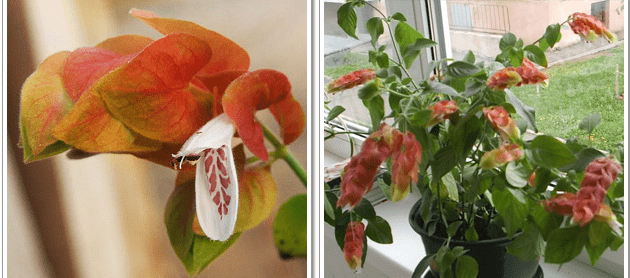The Shrimp plant or Justicia Brandegeeana (formerly Beloperone Guttata) is native to Mexico. Semi-shrub, reaching a height of 1 m. The leaves are elliptical, pointed at the end, and gradually narrowed towards the petiole.
The leaves, like the stems, are finely pubescent, about 10 cm long, and 4 cm wide. The inflorescence is an ear. The flowers have bright bracts that become brighter with the growth of the inflorescence – from pale pink to rich salmon.
The flowers themselves are two-lipped, five-petaled, with a thin long tube, pure white, with maroon specks in the throat.
There are several varieties that differ in the color of the bracts – in some, they are bright yellow, in others, they are pink or brick-colored. Flowering is long.
Table of Contents
Shrimp Plant Sisters (Other Varieties)
- Justice bright red or meat red Justicia carnea (formerly Jacobinia bright red Jacobinia carnea or Jacobinia Fields Jacobinia pohliana – all this is the same plant) – comes from Brazil. Semi-shrub, up to 1.2-1.5 cm high. The leaves are ovoid, dark green, sometimes with a bronze tint, about 15-20 cm long, 8-12 cm wide, with noticeable venation, which makes the leaves look wrinkled. This type of Justicia, unlike the previous one, does not have bright bracts (they are green), but the flowers themselves – two-lipped, narrow long fused petals of a bright pink color. A pair of long stamens with dark brown anthers are clearly visible.
- Shadow justice / Justicia umbrosa – also comes from Brazil, practically does not differ from the previous species, only a little larger – the bushes reach 1.8-2.5 m in height, and the flowers are bright yellow. A cultivar with white flowers has been bred.
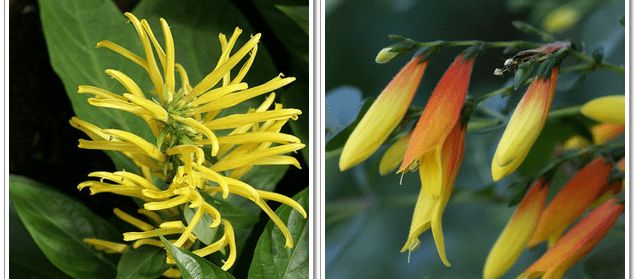
- Justicia Rizzini Justicia rizzinii (formerly Jacobinia pauciflora) is native to Brazil. A real dwarf among other justicias is a well-branched shrub, about 30-50 cm in height. The leaves are dark green, opposite, oblong in shape, narrowed at the end and at the base, smoothly turning into a short petiole. The leaves are only about 2-4 cm long, and 1-2 cm wide. The flowers are tubular, drooping, about 2 cm long, bright yellow, and red at the base, collected in 3-5 pieces in axillary racemose inflorescences. Blooms profusely in late winter-spring.
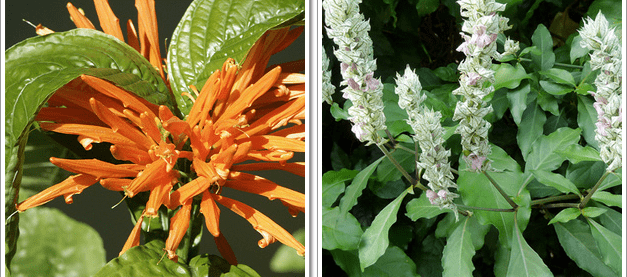
It is noteworthy that the indigenous people of Mexico have used the growing species of Justicia in their household since ancient times – dye (Muitle), indigo (gray-blue), which is used to dye fabrics and wool, is obtained from the leaves of Justicia Spicigera. If the leaves are placed in hot water, it turns black and then dark blue.
- Also of interest is the species Justicia literal Justicia Betonica – native to South, East Africa, and India, a shrub reaching a height of 2 m (in room conditions up to 1 m). The leaves are opposite, oblong-oval, 6-15 cm long and 2.5-4 cm wide, pointed at the end and gradually tapering into a petiole, slightly wavy. This Justicia is notable for the color of the bracts – they are cream-green or cream-gray with green veins, and the flowers themselves are light purple. It blooms profusely, on each shoot there are several inflorescences (about 12 cm long, erect), and bushes well.
Shrimp Plant Care
Temperature
Shrimp plants prefer moderate temperatures – in summer the optimum is within 20-25°C. In winter, the temperature should be somewhat cooler – in the range of 16-18°C, at least 15°C.
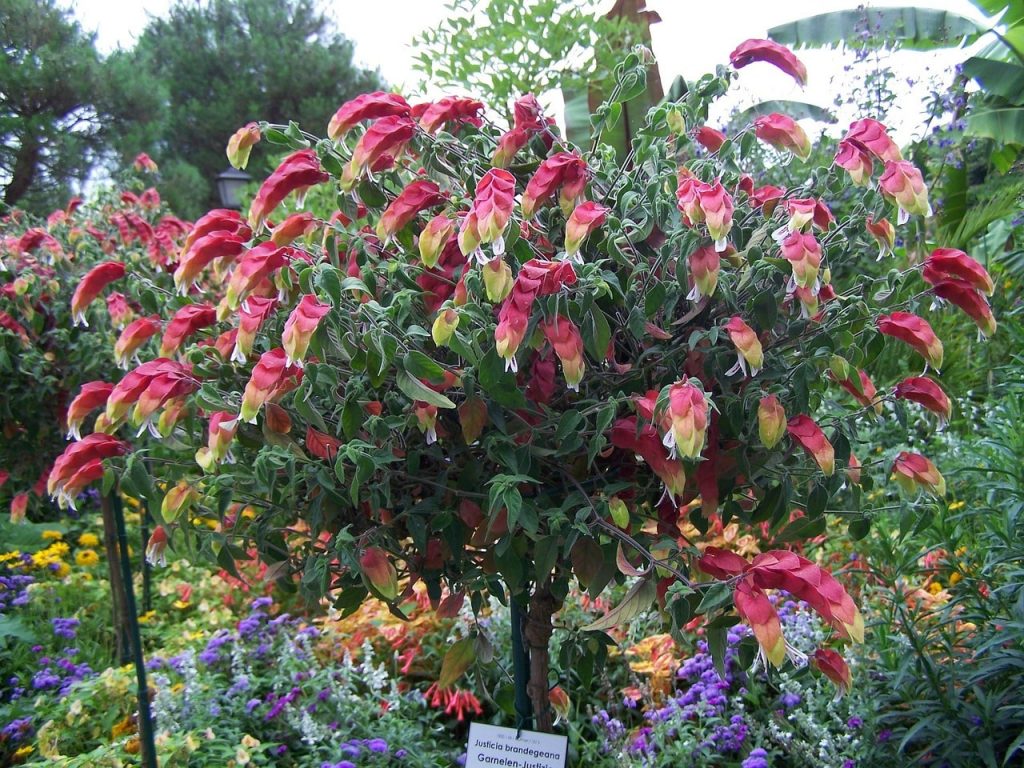
Shrimp plants do not tolerate keeping in warm, heated rooms in winter, especially with a lack of light. The shrimp plant blooms very profusely and for a long time, and it needs a rest of 3-4 months, during which the leaves do not fall, but the growth stops completely.
Lighting
Bright diffused light with some direct sunlight in the morning or evening. An east or northwest window that is not shaded from the street is best suited.
On the southern and western windows, shrimp plants will have to be shaded, but here it is dangerous not only the direct sun, which can leave burns on the leaves but also the heat, from which the inflorescences and leaves dry and fly around.
Watering Shrimp Plant
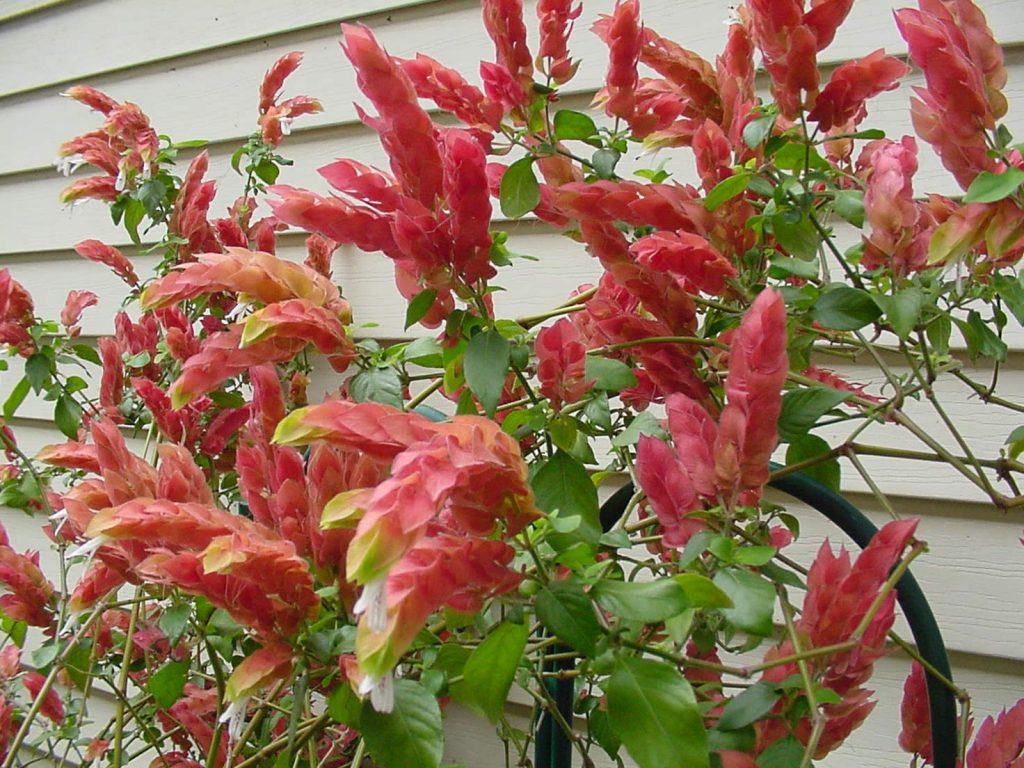
plentiful during the period of growth and flowering, by the next watering the soil should have time to dry out in the upper third of the pot, and in the depths to be slightly moist all the time.
In winter, watering is limited, its frequency depends on the temperature, the main thing is that the earth has time to dry out in the upper half of the pot.
Air humidity
Most acanthus, including shrimp plants, like moist air. The optimum humidity is 50-60%. In summer, spraying twice a day in dry weather is sufficient.
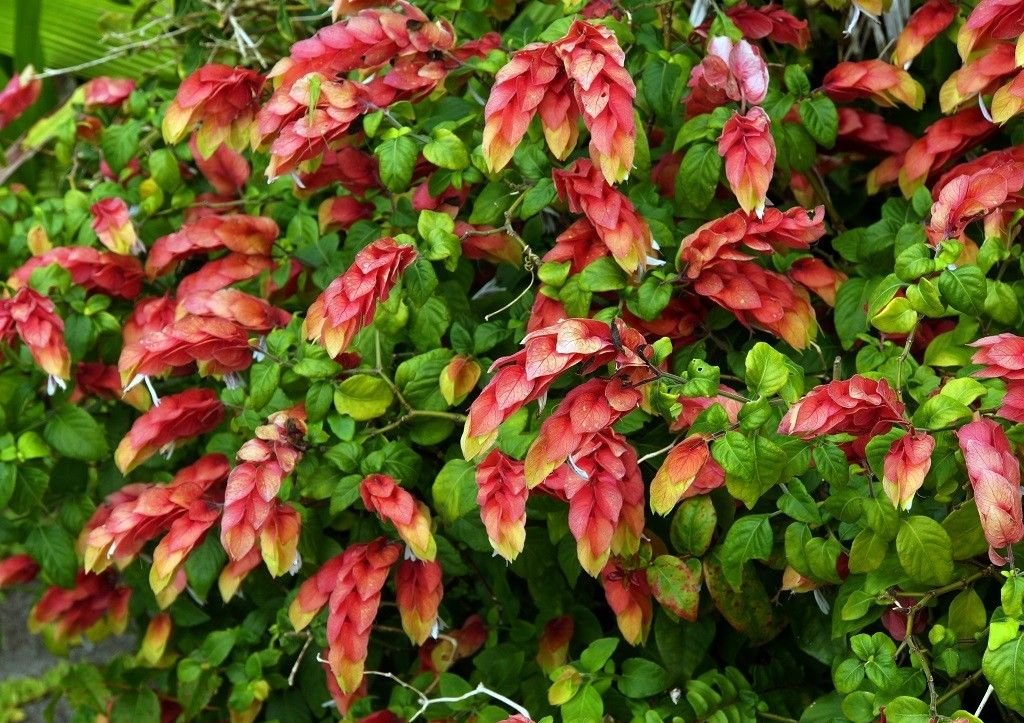
If you keep the shrimp plant in winter at a temperature not higher than 20 ° C, you can spray it once or twice a day, and this will be enough. But at a higher temperature, spraying briefly relieves the situation.
If the shrimp plant is small and stands on the window, you can isolate the window sill from the battery with a high sheet of polycarbonate or greenhouse film and put the shrimp plant itself on a wide pallet with wet moss.
Top dressing
During the growth period – from April to August, shrimp plant is fed every two weeks with fertilizer for flowering plants (“Fertik-lux”, “Bona-forte” or “Agricola” for blooming, “cheerful florist”, “Uniflor-bud” and others).
Transplanting Shrimp Plant
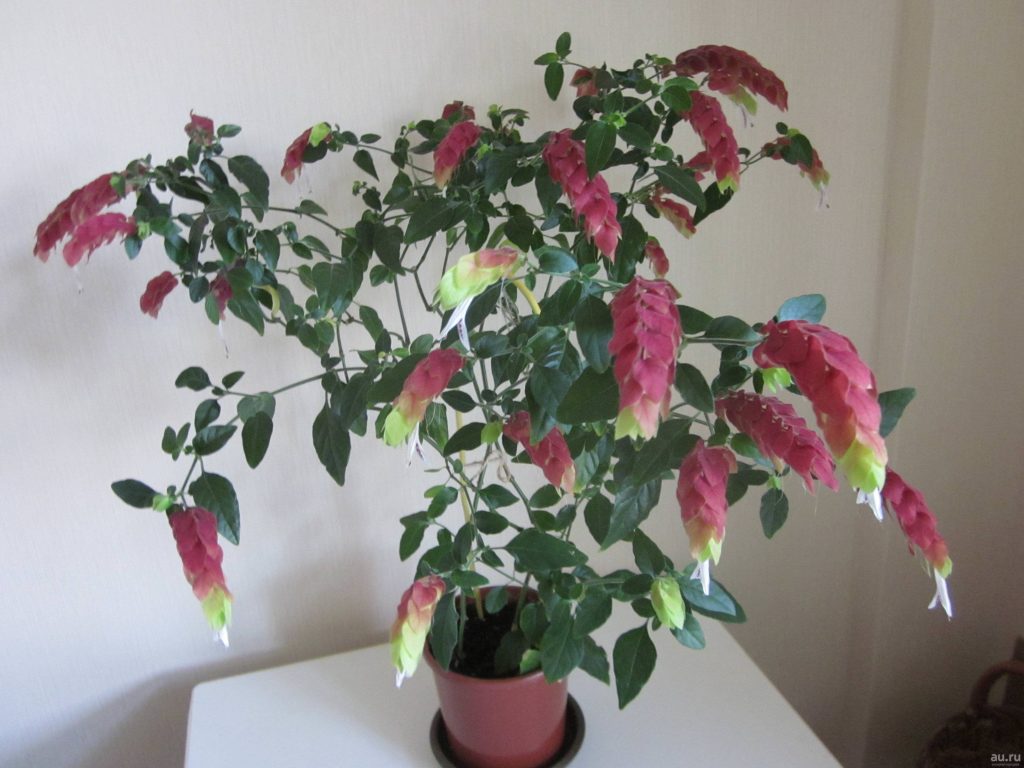
Annually in the spring. The soil should be nutritious, but loose. The approximate composition of the mixture: 2 parts of soddy land, 1 part of the leaf (peat), 1 part of humus (compost), and 1 part of sand.
Good drainage is a must. As a baking powder, you can add vermiculite and pine bark (it slightly acidifies the soil). pH \u003d 5.1-6.5 shrimp plant does not like alkaline soils, it grows on slightly acidic and neutral ones.
Shrimp Plant Propagation
Non-lignified stem cuttings that root easily, almost throughout the year. Cut cuttings should be placed in water, and placed in a jar in a wide transparent bag, the edges of which should not be tied, but simply straightened. This will increase the humidity around the cutting.

After the roots grow about 5 cm, they can be planted in small pots, two or three pieces together. As the cuttings grow, they must be transferred (without disturbing the root ball) into a large pot.
Crown Formation
After the cuttings take root and form 3-4 pairs of new leaves, pinch the ends of the shoots. The regrown branches are pinched again when they grow by about 10 cm.
In the first year after rooting, the cutting should not be allowed to bloom, this depletes the shrimp plant, it is better to try to form a crown – to achieve more branching, in this case, future flowering will be more abundant.
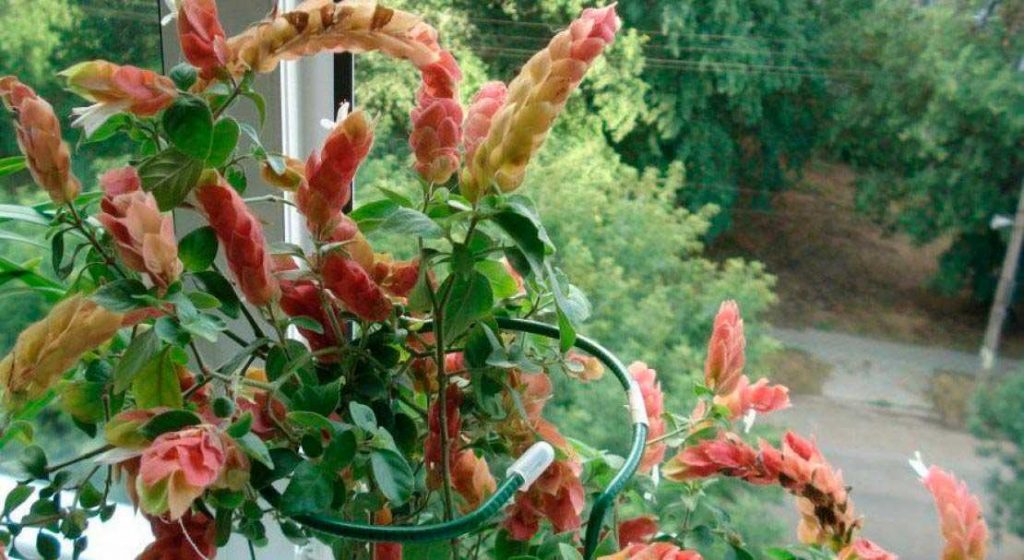
In addition, most shrimp plants have large leaves, such burdocks will not fit on any windowsill, and regular pinching helps to restrain growth. Reducing the amount of leaf mass allows the use of special preparations, and retardants, for example, “Athlete”.
Growing Problems of the Shrimp Plant
Shrimp plants equally badly tolerate both the drying of the earth and the overflow. The reaction is always the same – yellowing and flying around the leaves.
When overdrying, first of all, the lower leaves fly around, from waterlogging – the tops of the shoots wither and droop, and the rest of the leaves do not dry, but turn black.
Therefore, if you have had a shrimp plant recently, check the need for watering, not calculating the days of the week, and not by the weight of the pot, but by touch, digging deeper into the ground.

Still, the main problem of shrimp plants is proper wintering, so that there is enough light and the temperature is not higher than 18 ° C.
If the frames on the windows are wooden, it is not difficult to maintain such a temperature, it is more difficult with plastic windows and with large plants that do not want to fit on a small windowsill. In this case, the plant will either have to be given away, where the wintering can be cool and bright, or taken out to the landing, if it is light there and the temperature in winter is not higher and not lower than 15-18 ° C.
With proper wintering, the problem with dry air disappears by itself, but in a warm or hot room, dry air leads to leaves flying around (mainly in the lower part of the stems) and contributes to spider mite damage.


